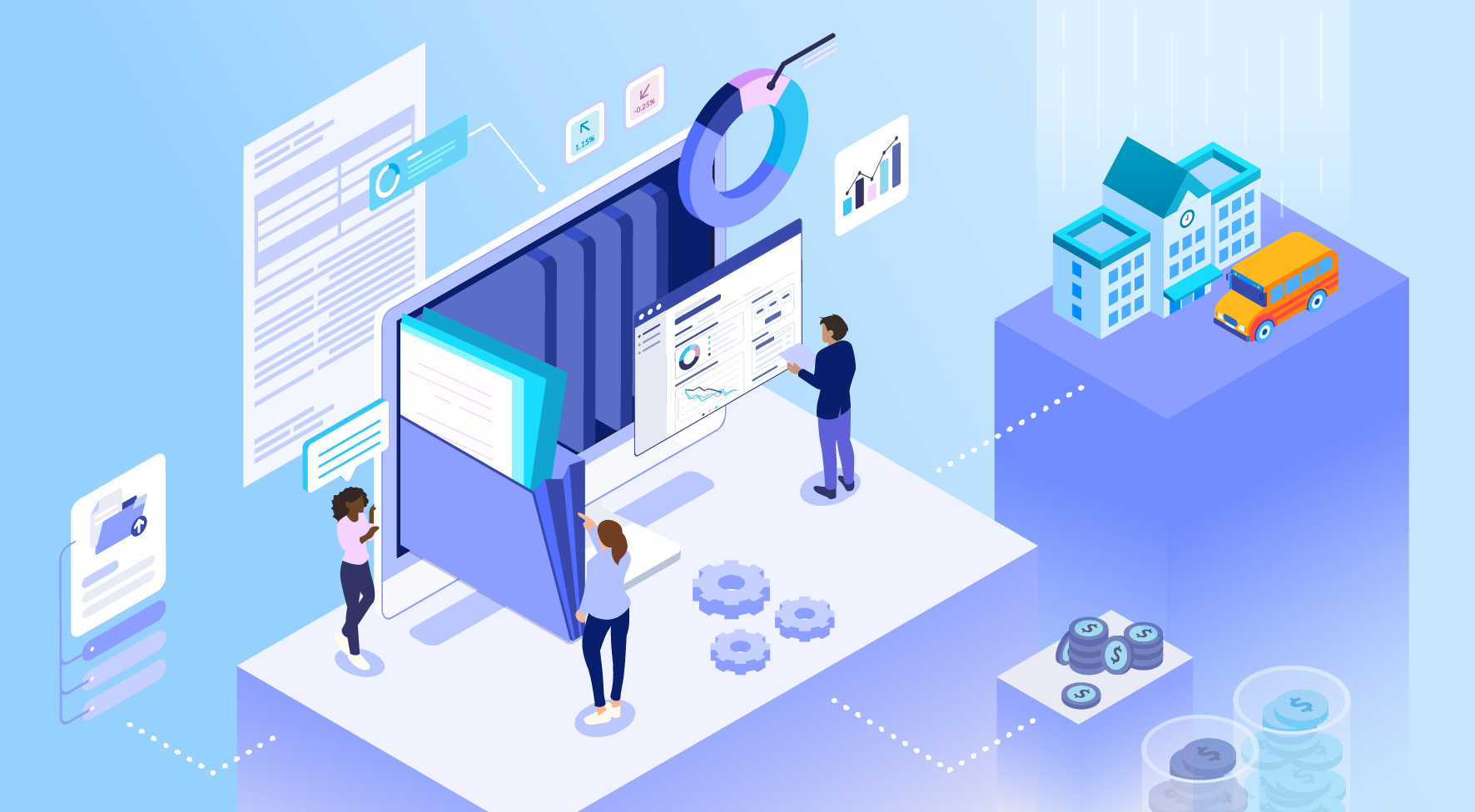Last week, we talked about the future of K-12 school district resource allocation strategies and the notion of expanding access to educational opportunities across the traditional space and time parameters of student-to-school relationship. This week, we’ll explore my predictions for the future of education technology as it relates to resource allocation and school system operations.
Manual processes reign in K-12 fiscal operations
When I founded Allovue a decade ago, I was struck by the overwhelming focus on instructional tools in the EdTech community relative to utterly scant innovation on the administrative and operations side of the house. Reimagining K-12 education to accommodate a rapidly fluctuating student population with increasingly diverse instructional needs (and options) will require a categorically different approach to resource allocation and management, yet the workflow and data tools for managing the flow of money, people, time, and supplies have remained stubbornly stuck in decades-old technology or manual processes. The public sector in general is pressured to take a "penny-wise and pound-foolish" approach to investments in administration and operations; especially in education, school systems are pushed to funnel maximum dollar amounts into classrooms—often with counterproductive results for administrative efficiency.
I often see legislators and community members question why school systems don’t operate with the fiscal efficiency of the private sector, and then question the purpose of administrative spending in the very next breath. I would argue that there’s plenty of unseen waste and bloat in the private sector that eludes scrutiny in the absence of detailed public financial reporting, but the private sector typically does value and invest in the very type of purpose-built technology solutions that their public sector peers would be pilloried for purchasing. Instead, public sector leaders often persist with “free” manual or home-grown solutions that inevitably cost the organization several times over by way of increased human capital costs, data errors, and loss of institutional knowledge via retiring staff who, by necessity, stored decades of detailed process and information components in their heads.
Drivers of change in EdTech innovation
The education sector’s reluctance to invest in administrative solutions creates a chicken-and-egg problem: innovators are discouraged from building modern solutions for an unmotivated buyer and education administrators are constantly disappointed by an array of round-peg-square-hole solutions that are mostly hand-me-downs from other industries.
I predict that we’re about to see the tide change: the next wave of EdTech is in the back office support for administration and operations. There is a confluence of factors swirling around K-12 education that will entice or force school systems to adapt resource allocation strategies with a level of sophistication and complexity that eclipse what is possible with manual processes. We consider each in turn below.
1. Enrollment Crunch
As discussed in a previous predictions essay, K-12 enrollment is on the decline nationally due primarily to reduced birth rates and decreased immigration, compounded by a surge of alternative education options and state-funded school-choice programs. Optimizing for administrative economies of scale with finance, HR, nutrition, transportation, and other operational functions will be critical for maintaining and expanding equitable education offerings for students and families while offering competitive compensation packages for teachers. I predict that we’ll see a flattening and consolidation of administrative functions amidst increasing decentralization of instructional options.
2. Leadership Turnover
The rate of change in K-12 leadership is fast and furious: current estimates suggest that Superintendent turnover is approximately 25% per year. 75 million Baby Boomers are expected to retire by 2030, paving the way for a generation of digital natives to move into leadership roles. A new cohort of K-12 administrators who were raised with information at their fingertips and lifestyle automations for everything from their taxis to their grocery shopping will have limited patience for doing things like bus-routing, scheduling, staff planning, and program evaluation by hand. Isn’t there an app for that? When they start looking for solutions to their problems, the innovation economy will respond to meet the need.
3. Things Fall Apart
Most of the operational technology systems that schools are using today were built last century. Plenty of great things came out of 1986, but hopefully not your finance system. Because this has historically been an inefficient market segment, there are a few large companies that have cobbled together Frankensteinian offerings through mergers and acquisitions with shockingly minimal ongoing investment in technology upgrades. Over the next decade, many of these systems will begin to fail, crushed by decades of technical debt. The point at which the one person at the district or company who understands the code-base retires, there will be no choice but to start fresh with solutions built this millennium.
4. K-12 Only
I’m already seeing emerging solutions with an exclusive K-12 focus in the administrative and operations space igniting a sense of possibility with niche, purpose-built solutions tailored to the specific needs of school and district administrators. These companies eat, sleep, and breathe K-12 education and understand the unique challenges of designing and implementing resource allocation processes focused on improving educational outcomes for students. I see transformative K-12 innovations popping up around hiring, teacher retention, scheduling, nutrition, transportation, facilities management, cybersecurity, and more.
When I started Allovue, I imagined a world where executives of billion-dollar companies would look on with envy and say, “I wish we had the kind of tools they have in Education.” I still believe that world is possible—a world in which the leaders facing the most difficult resource allocation challenges who are tasked with making the most consequential decisions are fully equipped with world-class innovations to get the job done. On my most optimistic day, I hope the general public will encourage schools to proactively pursue these types of solutions now; on my most cynical day, I suspect the public education system will have to be on the brink of total collapse in order to adopt this level of change. Either way, pushed or pulled, I believe this shift will happen this decade. We can only go forward.
What district administrators have to say
Below is commentary on this topic from two district administrators with Cincinnati Public Schools: Mike Gustin, Director of Business Technology, and Jen Wagner, Treasurer/CFO.
Question: What percentage of the solutions that you personally work with do you think are explicitly designed for K-12 v. designed for broader/other industries?
Response: Currently, the vast majority of our solutions are designed for K-12. This has been a very thoughtful choice on our part, as we have replaced more general business solutions with K-12 specific ones over the last six years. We have adjusted our procurement process for large system purchases to look for vendors with demonstrated K-12 experience. Exceptions to this would be our standard office toolsets (Google suite and Microsoft Office) as well as external financial web applications, such as with our bank or purchase card vendor.
Question: Are you able to tell when a solution is designed especially for K-12? What are some telltale signs in your experience as a product user/partner?
Response: Yes, there are certain features that tend to exist or be more robust when a solution is designed for K-12. On the general ledger side, this is shown with how the system handles fund accounting. For procurement applications, K-12 systems tend to have well-developed business rules around purchase orders. In HR and payroll systems, you will see the ability to track and pay employees by contract, not just hours work. These K-12 systems will also have the ability to pay employees on a different schedule than the one worked. This allows teachers and other school-based employees to be level-paid over the summer.
Question: What are some potential problems or challenges you have experienced when you are trying to do your job with tools that aren't made for your specific needs?
Response: School districts are highly regulated by their respective states and reporting accurate data to state agencies is critical. Systems need to be flexible enough to capture the data correctly at the beginning of a transaction and carry it through to reporting. As mentioned above, the length and complexity of our general ledger accounts, as well as the overall number of accounts needed, can be a challenge for system vendors. Similarly, K-12 organizations have unique rules for Human Capital management. One example is the need to track teacher licenses, both for payroll compliance and for instructional quality. In previous systems, all of this data was stored in custom, text-based fields. In our current system, the data now resides in integrated tables with defined date fields and dropdown lists. This enables better reporting, integration with other platforms, and workflow notifications of important events.
Question: Have you ever given up on trying to find a solution to meet your needs and resorted to manual processes?
Response: I would not say we’ve resorted to a manual process, however, I would agree that we have kept some manual processes because a solution that meets our needs doesn’t exist. I would also say we’ve done a large amount of custom development work to address gaps in existing systems or to conform to our district-specific rules.
Question: Do you see any opportunities to improve K-12 operations with technology and innovation that is focused specifically on the K-12 user experience? What are some examples?
Response: Yes, having solutions that are tailored to the K-12 user experience reduces the amount of customization and configuration needed per solution. It should enable better reporting and data visibility as well. On the flip side, we want K-12 solutions to keep pace with those made for broader usage as new features are introduced. We don’t want to trade functionality for familiarity, we want both. One example we have worked on extensively is streamlining the purchasing process. At our homes, and even in many businesses, purchasing can be as easy as saying “Alexa, order me a _____ ." The challenge for an innovator would be to provide that same ease-of-use to the requestor while also ensuring compliance with our budget and spending rules. Other industries have been able to combine their financial and operational information into a single picture, but K-12 is still working through this process. It will help us greatly to have solutions that have performance tracking and per-student costs built into the planning and resource allocation systems.
This article is the fifth in a series that reviews “10 Predictions for the Next 10 Years of Education Finance.” Read other topics in the series now:

ABOUT THE AUTHOR
Jess Gartner is the founder and CEO of Allovue, where edtech meets fintech - #edfintech! Allovue was founded by educators, for educators. We combine powerful financial technology with education data, giving administrators the power to connect spending to student achievement. Jess has been featured as one of Forbes Magazine’s 30 Under 30 in Education (2015, 2016 All-Star), The Baltimore Sun’s Women to Watch (2013), and Baltimore Magazine’s 40 Under 40 (2013). In 2014, she was recognized as the Maryland Smart CEO Innovator of the Year in the Emerging Business category. Before founding Allovue, Jess studied education policy at the University of Pennsylvania and taught in schools around the world, including Thailand, South Africa, Philadelphia, and Baltimore. She taught middle school humanities in Baltimore City and received her M.A. in teaching from Johns Hopkins University.


